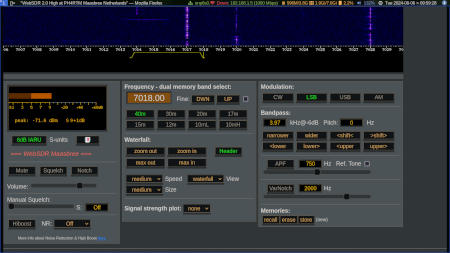UPDATE: Quite a lot of internet SDR operators are switching to RX-888 receivers and PhantomSDR+ instead of classic WebSDR. Combining the RX-888 with PhantomSDR+ produces a full VLF through HF spectrum, with no gaps. The WebSDR sites I discuss below are running very nicely and picking up plenty of signals. Try both types and use what you like the most!
It was Tuesday, August 6th, 2024, at about 0940 UTC, when I noticed them. The WebSDR site in Maasbree, Netherlands, has gone live with an upgraded front end. They are now running the RX-888 Mk2, and the signals coming in are fantastic: clean, steady, and dead-on frequency. This was an upgrade scheduled for the end of July, except the sysop team had encountered some sort of software problem, and were keeping the WebSDR on its old configuration for a while longer. But then, listings for the new interfaces showed on WebSDR.org. They've gone live, baby! They've effen' gone live!
Single Source Wideband WebSDRs
With the Maasbree, NL WebSDR going online, there are now three servers using the RX-888 Mk2 SDR to provide wideband, single source spectrum coverage:
- Test receiver, Northern Utah WebSDR (port 8909)
- Low HF Amateur Bands, Maasbree WebSDR (port 8930)
- High HF Amateur Bands, Maasbree WebSDR (port 8931)

end, with precise tuning and super clean reception.
These WebSDR upgrades are important because they replace multiple SDR devices, with their various levels of performance and design specifications, with one device of high quality. To run a mix of RTL-SDRs, Airspy, and SDRplay devices, operators would need to set up each one individually - satisfying the power requirements, cables, filters, software drivers, and frequency tweaks to create a good WebSDR experience for visitors.
Using just one RX-888 Mk2, the operator sets up one physical device, then uses software to distribute spectrum data for multiple bands shown to WebSDR users. It is really good, as now the WebSDR is working with 16 bit data across all bands, not the 8, 12, or 14 bit depths offered by various other devices. Even better yet is the ability to use a GNSS-disciplined clock oscillator, so the frequency tuning is very precise and has extremely low jitter or phase noise. Not only does that improve receiver sensitivity; it allows far better reception of weak-signal modes such as WSPR, QRSS, FT8, and the like.
A Wideband WebSDR (if Desired)
The Northern Utah WebSDR appears to have its RX-888 test server running each band about 1536 kHz wide, which offers ample coverage of interesting services outside of the amateur bands. Over at the Maasbree WebSDR, listeners will find an experience more tightly focused on the ham bands, receiving spectrum 384 or 192 kHz wide.
As an end user, I am finding the consistent quality across all of the frequencies covered by these WebSDRs to be a good thing. I can set up my digimode decoder software, then enter some favorite frequencies to monitor, and have each one work fine, with no problems. Decoding weak signals in WSJT-X works nicely too. There's some solar flaring going on today, and the results therefore seem inconsistent - sometimes better and sometimes worse than the same signals being checked against a proximate RTL-SDR-based site I am connected to on a separate computer.
For WebSDR site operators, this technological breakout will provide a more efficient, flexible, and consistent configuration. Instead of juggling a bunch of temperamental dongles, the task reduces to juggling just one. Note that both sites shown here also use a GNSS disciplined clock oscillator, but that isn't mandatory. I would argue that it is a good tradeoff to get rid of the other dongles, but add that oscillator, since it reduces a source of noise and makes the WebSDR tuning dead-nuts stable and accurate.
© 2005 - 2025 AB9IL.net, All Rights Reserved.
Written and curated by Philip Collier / AB9IL.
About Philip Collier / AB9IL, Commentaries and Op-Eds, Contact, Privacy Policy and Affiliate Disclosure, XML Sitemap.
This website is reader-supported. As an Amazon affiliate, I earn from qualifying purchases.